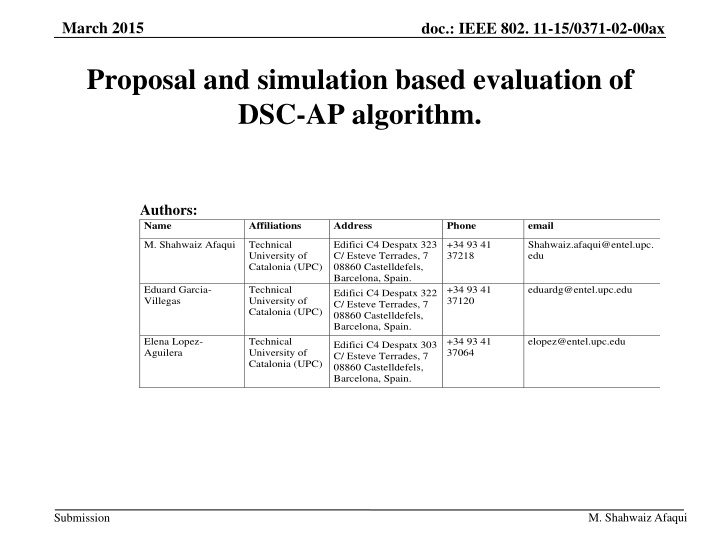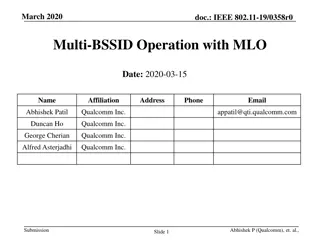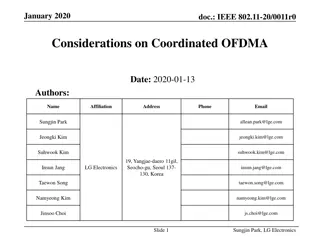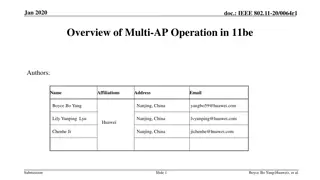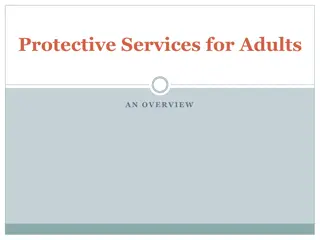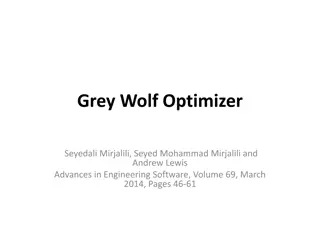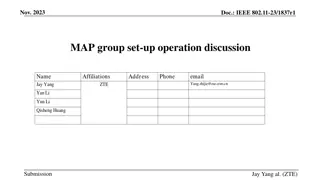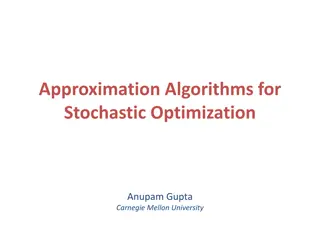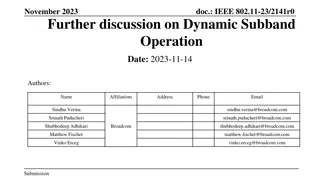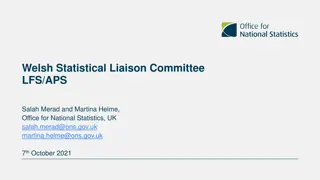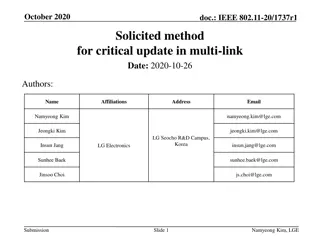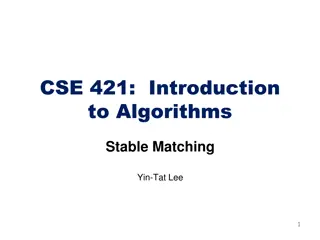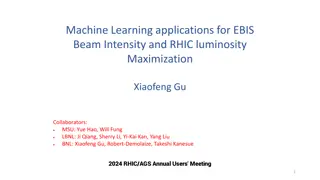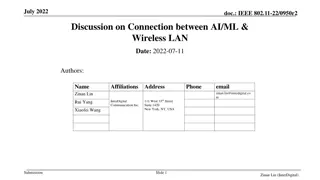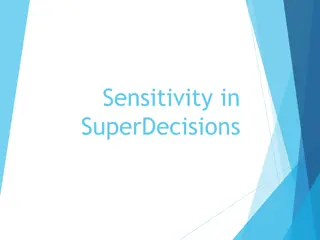Optimization of Dynamic Sensitivity Control Algorithm for APs
Proposal and simulation-based evaluation of the DSC-AP algorithm in IEEE 802.11 networks operating at 5GHz. Explore the impact of DSC on asymmetric uplink and downlink traffic, and suggest parameters for optimizing AP performance.
Download Presentation

Please find below an Image/Link to download the presentation.
The content on the website is provided AS IS for your information and personal use only. It may not be sold, licensed, or shared on other websites without obtaining consent from the author.If you encounter any issues during the download, it is possible that the publisher has removed the file from their server.
You are allowed to download the files provided on this website for personal or commercial use, subject to the condition that they are used lawfully. All files are the property of their respective owners.
The content on the website is provided AS IS for your information and personal use only. It may not be sold, licensed, or shared on other websites without obtaining consent from the author.
E N D
Presentation Transcript
March 2015 doc.: IEEE 802. 11-15/0371-02-00ax Proposal and simulation based evaluation of DSC-AP algorithm. Authors: Name Affiliations Address Phone email M. Shahwaiz Afaqui Technical University of Catalonia (UPC) Edifici C4 Despatx 323 C/ Esteve Terrades, 7 08860 Castelldefels, Barcelona, Spain. Edifici C4 Despatx 322 C/ Esteve Terrades, 7 08860 Castelldefels, Barcelona, Spain. +34 93 41 37218 Shahwaiz.afaqui@entel.upc. edu Eduard Garcia- Villegas Technical University of Catalonia (UPC) +34 93 41 37120 eduardg@entel.upc.edu Elena Lopez- Aguilera Technical University of Catalonia (UPC) +34 93 41 37064 elopez@entel.upc.edu Edifici C4 Despatx 303 C/ Esteve Terrades, 7 08860 Castelldefels, Barcelona, Spain. M. Shahwaiz Afaqui Submission
March 2015 doc.: IEEE 802. 11-15/0371-02-00ax Outline 1. 2. 3. 4. 5. 6. 7. 8. 9. 10. Conclusions/next steps 11. References 12. Appendix Context Simulation Environment: NS-3 Simulation scenarios and assumptions Metrics used for evaluation Effects of DSC over a network operating at 5GHz Impact of DSC in asymmetric uplink plus downlink traffic Dynamic Sensitivity Control for Access Point (DSC-AP) Selection of suitable parameters for DSC-AP Combining DSC at Uplink and DSC-AP at downlink with asymmetric traffic M. Shahwaiz Afaqui Submission Slide 2
March 2015 doc.: IEEE 802. 11-15/0371-02-00ax Abstract A mechanism to dynamically set the CCA threshold on the AP is presented, which is based on DSC. A simulation-based study shows i) under asymmetric traffic, there is no gain in having DSC STAs but not DSC at the AP; ii) expected gains of DSC-AP in an apartment scenario; and iii) the optimal setting for DSC-AP. M. Shahwaiz Afaqui Submission Slide 3
March 2015 doc.: IEEE 802. 11-15/0371-02-00ax 1. Context 13/1290-01 proposed Dynamic Sensitivity Control (DSC) for HEW 15/0027r1 evaluated the performance of DSC in residential scenario with only uplink traffic and exposed the benefits of DSC to increase throughput in dense scenarios. Average improvement <10% in throughput (potential improvement of 35% in bad conditions) Positive: reduce exposed nodes (increases throughput and fairness) Negative: increase in hidden nodes (increases FER and medium access delay) Slight impact on legacy devices maximal overall gain when all STAs implement CCA adaptation In typical SOHO BSSs, traffic is asymmetric (downlink >> uplink traffic) Through simulations, we justify the need of DSC algorithm also for Access Points (APs). In this submission we, Study the effects of DSC algorithm over a network operating in 5GHz. Analyze the impact of DSC in asymmetric uplink plus downlink traffic. Propose a new DSC algorithm to be implemented at the AP (to assist AP traffic). Recommend parameters to be employed for DSC-AP algorithm. Explore the impact of DSC at Uplink and DSC-AP at downlink over asymmetric traffic. M. Shahwaiz Afaqui Submission Slide 4
March 2015 doc.: IEEE 802. 11-15/0371-02-00ax 2. Simulation Environment: NS-3 (1/2) NS-3 is a simulator for Internet systems It allows the study of protocols and network performance of large-scale systems in a controlled and scalable environment. Main characteristics Discrete event simulator Packet level simulator (layer 2 and above) Layered architecture Free and open source Frequent updates ( latest version ns 3.22- release date 06-02-2015) Large number of protocol implementations and models available TCP, UDP IPV4, IPV6, static routing IEEE 802.11 and variants, WiMAX, LTE IEEE 802 physical layer Mobility models and routing protocols Ability to design indoor, outdoor or hybrid networks etc. M. Shahwaiz Afaqui Submission Slide 5
March 2015 doc.: IEEE 802. 11-15/0371-02-00ax 2. Simulation Environment: NS-3 (2/2) Limitations Simple PHY layer abstraction IEEE 802.11ac model has not yet been developed and current results focus on IEEE 802.11g/n. Challenges dense WLAN scenario with multiple OBSS generated in NS-3 where the simulation package is modified to, allow STAs to measure the energy level of received beacon frames. improve hybrid building pathloss model to accommodate floor penetration losses. modifications /new additions made to accommodate real time operation of DSC algorithm. M. Shahwaiz Afaqui Submission Slide 6
March 2015 doc.: IEEE 802. 11-15/0371-02-00ax 3. Simulation scenarios and assumptions (1/2) Topology multi-floor residential building, 5 stories. 2 10 apartments per story. Apartment size: 10m 10m 3m. 1 AP placed randomly in each apartment at 1.5m height. channel selected randomly for each cell. For 2.4GHz: three channel scheme (1, 6, 11) ~1/3 of the cells share the same channel. For 5Ghz: ten channel scheme ~1/10 of the cells share the same channel. 5 STAs placed randomly around their respective AP. M. Shahwaiz Afaqui Submission Slide 7
March 2015 doc.: IEEE 802. 11-15/0371-02-00ax 3. Simulation scenarios and assumptions (2/2) Frequency band: focused on 5GHz for DSC and 2.4GHz for DSC-AP, Intend to investigate the impact of DSC-AP in a band that is more restricted in dense environments. Traffic: UDP CBR Uplink and downlink transmission in saturation conditions is considered, For IEEE 802.11n at 5GHz, only uplink transmission and saturation condition is considered. For asymmetric traffic, uplink transmission rate is set to one-fifth of downlink transmission rate and saturation conditions are established within each cell. Pathloss model: Hybrid Building Propagation loss model [1], obtained through a combination of several well known pathloss including indoor (through walls, floors) and outdoor (urban, suburban, open). We simulated hundreds of random scenarios with and without utilizing the DSC and DSC-AP. Additional simulation details are provided in the appendix. M. Shahwaiz Afaqui Submission Slide 8
March 2015 doc.: IEEE 802. 11-15/0371-02-00ax 4. Metrics used for evaluation Aggregate throughput and STA s individual throughput Frame Error Rate (FER) ratio of data frames received with errors to total data frames received. Fairness Number of hidden nodes Hidden node: detected when a node that is located outside the sensing range of the transmitter is able to interfere in the ongoing transmission from the transmitter to the receiver. A pair of hidden nodes (e.g. T1 and T2) is considered a single entry. calculated according to Jain s fairness index [2]. T1 R T2 Number of exposed nodes Exposed node: detected when a node is needlessly silenced to concurrently transmit, even though the node is not able to generate ample interference that could cause collisions at the receiver. A pair of exposed nodes (e.g. T1 and T2) is considered a single entry. T1 R2 R2 T2 M. Shahwaiz Afaqui Submission Slide 9
March 2015 doc.: IEEE 802. 11-15/0371-02-00ax 5. Effects of DSC over a network operating at 5GHz (1/2) 350 1 with DSC with DSC Aggregate throughout (Mbps) 300 0.95 Without DSC Without DSC 250 0.9 200 Fairness 150 0.85 100 0.8 50 0 0.75 MCS7+PS1000+RCHS MCS7+PS1000+OPCHS MCS0+PS1500+RCHS MCS0+PS1500+OPCHS MCS7+PS1000+RCHS MCS7+PS1000+OPCHS MCS0+PS1500+RCHS MCS0+PS1500+OPCHS Observations: With more non-overlapping channels available (i.e. more than 10), DSC algorithm was found to have no impact on the throughout gains. Slight increase in fairness was noted for random channel selection scenario. Nevertheless, optimal channel selection produces gains ~20% Conclusions: The impact of DSC on IEEE 802.11n network operating on 5GHz is minimal. Channel selection does have an impact It is expected that aggregation increases the interest of using DSC in the 5GHz band M. Shahwaiz Afaqui Submission Slide 10
March 2015 doc.: IEEE 802. 11-15/0371-02-00ax 5. Effects of DSC over a network operating at 5GHz (2/2) 0.3 1800 with DSC % Increase in hidden nodes 1600 MCS7+PS1000+RCHS 0.25 Without DSC 1400 MCS7+PS1000+OPCHS 0.2 1200 MCS0+PS1500+RCHS FER 1000 0.15 MCS0+PS1500+OPCHS 800 0.1 600 400 0.05 200 0 0 MCS7+PS1000+RCHS MCS7+PS1000+OPCHS MCS0+PS1500+RCHS MCS0+PS1500+OPCHS Observations: FER is slightly increased when DSC is used within the network. Number of hidden nodes reduced with the inclusion of optimal channel selection. The presence of exposed nodes in driven to 0 by DSC algorithm. Conclusions: Similar to throughput and fairness results, minimal differences were witnessed. These results highlight the fact that DSC makes more sense under really dense scenarios. M. Shahwaiz Afaqui Submission Slide 11
March 2015 doc.: IEEE 802. 11-15/0371-02-00ax 6. Impact of DSC in asymmetric uplink plus downlink traffic 30 2 1.8 % Increase in throughput 25 1.6 % Increase 20 1.4 1.2 15 1 0.8 10 0.6 0.4 5 0.2 0 0 Overall Uplink Downlink Fairness FER Hidden nodes Observations: A marginal improvement in overall throughput was witnessed, where DSC was still able to cause some increase in uplink traffic. Small increase in fairness was observed. DSC increased FER and hidden nodes with the network. Conclusions: True benefits of DSC can not be achieved if not applied in the direction on the traffic (i.e., the AP should also apply a CCA adaptation). M. Shahwaiz Afaqui Submission Slide 12
March 2015 doc.: IEEE 802. 11-15/0371-02-00ax 7. Dynamic Sensitivity Control for Access Points (DSC-AP) (1/2) As discussed in previous section, the effect of DSC is minimized when applied to asymmetric traffic. In this submission, we propose the modification of CCA threshold for APs based on the information gained through the STAs attached to the AP as well as the interference that could be caused by neighboring APs CCA threshold is set primarily based on associated STAs. But to assist specific cases of closely placed APs, interference from APs is used as a secondary mode to set CCA (only if the RSSI of currently associated STAs is less than the power received from interfering AP). M. Shahwaiz Afaqui Submission Slide 13
March 2015 doc.: IEEE 802. 11-15/0371-02-00ax 7. Dynamic Sensitivity Control for Access Points (DSC-AP) (2/2) Proposed DSC-AP varies CST levels at each AP in a distributed manner, AP sets its CCA Th. based on the furthest associated station. Multiple APs placed randomly in different rooms could lead to situation where neighbouring APs can be exposed. To rectify this problem, APs reduce their CCA based on received frames from other APs only if the signal power received from interfering AP is above the power received from the furthest associated station. Once the reference is determined, a margin is applied Flow chart highlights the basic operation of DSC-AP algorithm over AP stations in an infrastructure-based WLAN. M. Shahwaiz Afaqui Submission Slide 14
March 2015 doc.: IEEE 802. 11-15/0371-02-00ax 8. Selection of suitable parameters for DSC-AP 7 4 3.5 % Increase in throughout 6 % Increase in fairness 3 5 2.5 4 2 3 1.5 2 1 1 0.5 0 0 -22 -23 -24 -25 -26 -27 -28 -22 -23 -24 -25 -26 -27 -28 Margin Margin Observations: Only downlink traffic at saturation conditions are used to understand the impact of DSC-AP. Maximal gain with Margin at -25dB Conclusions: The proposed algorithm is able to increase the throughput along with fairness in a network where DSC algorithm in employed at the APs. M. Shahwaiz Afaqui Submission Slide 15
March 2015 doc.: IEEE 802. 11-15/0371-02-00ax 8. Selection of suitable parameters for DSC (2/2) 90 90 % Increase in hidden nodes 80 80 % Increase in FER 70 70 60 60 50 50 40 40 30 30 20 20 10 10 0 0 -22 -23 -24 -25 -26 -27 -28 -22 -23 -24 -25 -26 -27 -28 Margin Margin Observations: higher values of Margin result in less hidden nodes and, hence, smaller FER degradation. the presence of exposed nodes is driven to almost 0 by the DSC-AP algorithm Conclusions: a consequence of the increased number of hidden nodes, the overall FER in network is increased larger access delay. Margin of 25dB was observed to create a balance between the negative and positive aspects of DSC-AP M. Shahwaiz Afaqui Submission Slide 16
March 2015 doc.: IEEE 802. 11-15/0371-02-00ax 9. Combining DSC at Uplink and DSC-AP at downlink with asymmetric traffic 6 38 5.8 37.5 5.6 % Increase 37 5.4 % Increase 36.5 5.2 5 36 4.8 35.5 4.6 35 4.4 34.5 Overall Throughput Fairness FER Hidden nodes Observations: throughput results indicate around 6 % improvement for the cases when DSC algorithm is used at the STAs and DSC-AP algorithm is used at the AP over the conventional IEEE 802.11 protocol. Overall FER in the network increased from 0,14 to 0,19. Conclusions: Despite of increase in FER in the network, DSC and DSC-AP delivered notable throughput improvements. More benefits can be witnessed when asymmetric traffic scenario utilizing DSC and DSC- AP are evaluated in optimal channel selection scenarios. M. Shahwaiz Afaqui Submission Slide 17
March 2015 doc.: IEEE 802. 11-15/0371-02-00ax 11. Conclusions/next steps DSC scheme has minimum impact when applied to IEEE 802.11n network operating at 5GHz DSC isable to provide maximum benefits under worse conditions. Under asymmetric traffic, AP should take part on the dynamic CCA adaptation We propose a DSC-AP algorithm that is a DSC version for the Access Points, CCA is set according to the furthest associated STA/closest interfering AP Margin of -25 was observed to create a balance between the negative and positive aspects of DSC-AP in downlink only traffic in saturation conditions. DSC an DSC-AP schemes are analyzed under asymmetric uplink plus downlink traffic in saturation condition. The proposed mechanism helps to increase the over all throughput Next steps, Repeat study in different scenarios, including aggregation. Study the impact of enabling RTS/CTS along with DSC plus DSC-AP algorithm to further evaluate the impact on hidden nodes within the network. M. Shahwaiz Afaqui Submission Slide 18
March 2015 doc.: IEEE 802. 11-15/0371-02-00ax 11. References 1. 11-13-1290-01, Dynamic Sensitivity Control for HEW 2. 15/0027r1, Simulation-based evaluation of DSC in residential scenario 3. Hybrid buildings propagation loss model: ns3-design document. [Online]. Available: http://www.nsnam.org/docs/models/html/buildingsdesign.html 4. J. R., Fairness: How to measure quantitatively? ATM Forum/94- 0881, Sept. 1994. M. Shahwaiz Afaqui Submission Slide 19
March 2015 doc.: IEEE 802. 11-15/0371-02-00ax 12. Appendix M. Shahwaiz Afaqui Submission Slide 20
March 2015 doc.: IEEE 802. 11-15/0371-02-00ax Simulation assumptions PHY parameters Parameters4 Values Parameters Values Wireless Standard IEEE 802.11g and IEEE 802.11n Packet size 1000bytes Frequency band 2.4 GHz and 5GHz STA TX power 16dBm Physical transmission rate for IEEE 802.11n (2.4GHz) 72.2Mbps (MCS 7) Transmission gain 1dB Physical transmission rate for IEEE 802.11n (5GHz) i. 13.5Mbps (MCS0) 135 Mbps (MCS7) Reception gain 1dB ii. Channel width 20MHz for 2.4GHz 40MHz for 5GHz Noise figure 7dB Propagation delay model Constant speed propagation delay Energy detection threshold -78dBm Propagation loss model Hybrid buildings propagation loss Initial CCA threshold -80dBm Wall penetration loss 12dB Guard interval Short Floor penetration loss 17dB Data preamble Short M. Shahwaiz Afaqui Submission Slide 21
March 2015 doc.: IEEE 802. 11-15/0371-02-00ax MAC parameters Parameters Values Parameters Values Access protocol EDCA Retransmission attempts 16 RTS/CTS Disabled Maximum missed beacons for re- association 10000 Association 100% STAs associated to AP in an Apartment Active probing Disabled QOS Enabled Traffic model Best effort Aggregation Simulation parameters Disabled Parameters Values Parameters Values Simulation time 25 seconds Simulations for each hybrid case 24 Confidence interval 95% Simulations for non- DSC network 24 M. Shahwaiz Afaqui Submission Slide 22
